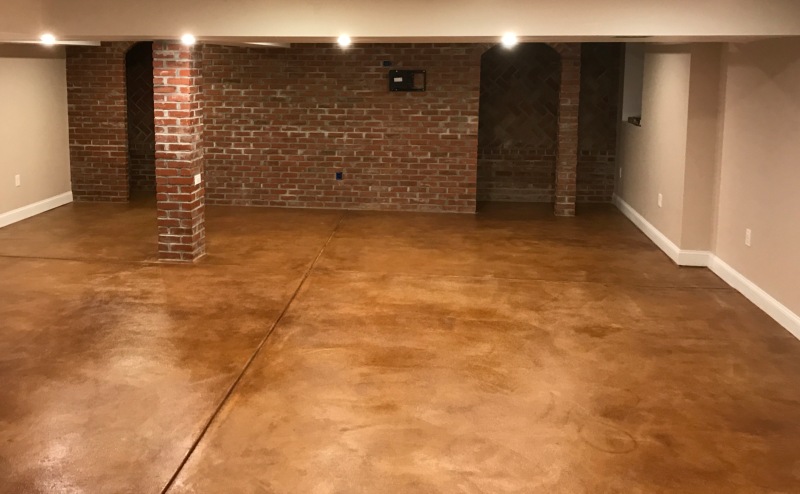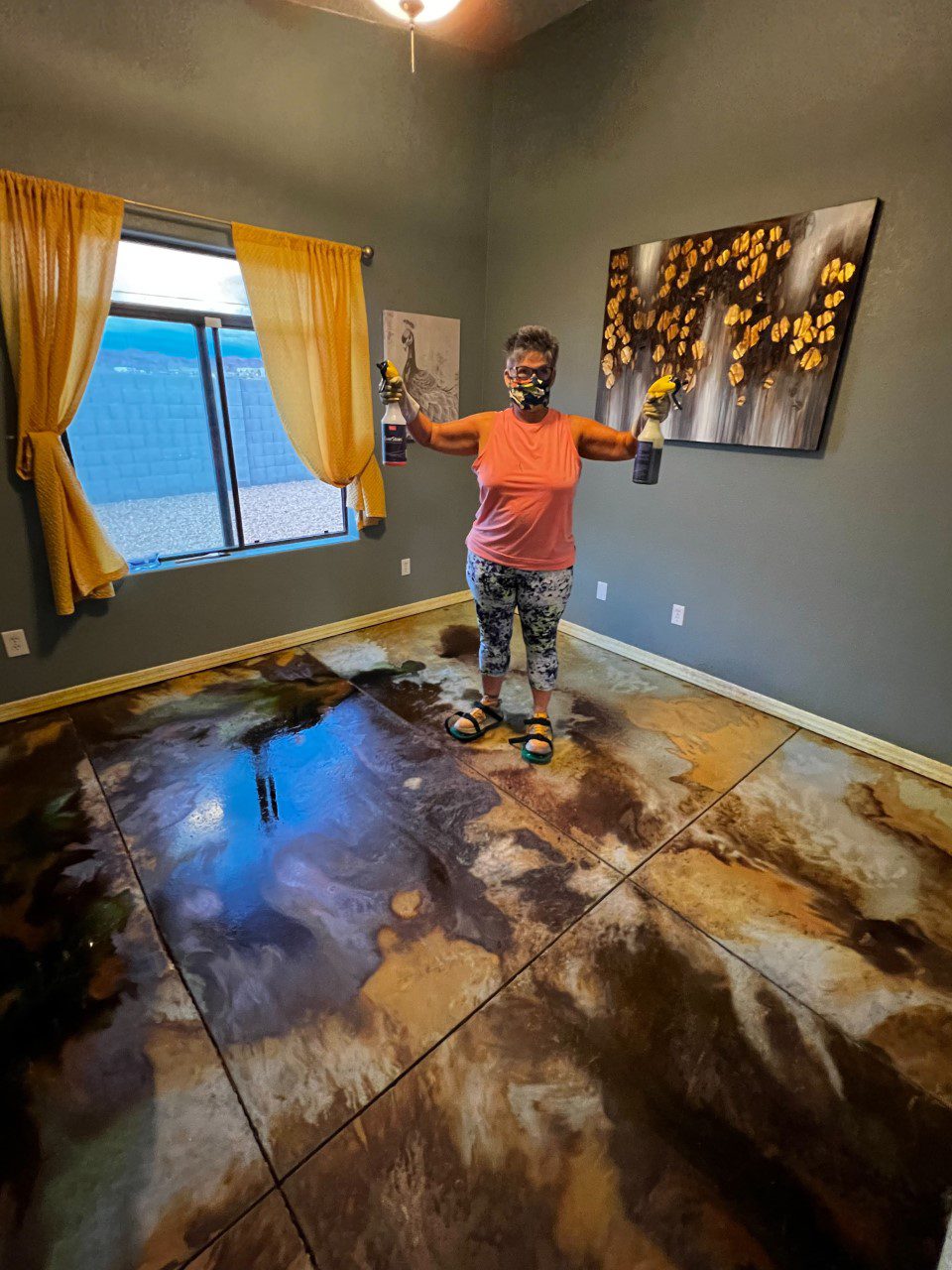How to properly set up for stained concrete flooring
Recognizing the Series Of Solutions Offered in Floor Covering: Highlighting Stained Concrete Techniques
Stained concrete has actually emerged as a compelling flooring alternative for various spaces. Its versatility depends on the selection between acid and water-based stains, each offering distinctive aesthetic appeals. Proper prep work and ongoing maintenance are crucial to guarantee its toughness and look. As the demand for cutting-edge flooring solutions expands, comprehending the subtleties of tarnished concrete techniques might open up new opportunities for both household and industrial settings. What one-of-a-kind advantages might this floor covering option bring to a job?
The Basics of Stained Concrete
Stained concrete works as a functional flooring option that integrates toughness with aesthetic allure. This flooring method involves applying a specially developed stain to the concrete surface area, which penetrates and modifies the shade of the material. The process not just improves the appearances of concrete yet also uses the advantage of shielding it from damage. Stained concrete can accomplish a large range of appearances, from earthy tones to dynamic tones, making it suitable for various style motifs.
Proper preparation of the concrete surface is important for excellent results. This may consist of cleaning, grinding, or etching to assure the stain adheres properly. On top of that, the application procedure typically includes making use of devices such as sprayers or brushes to accomplish consistent protection. After staining, a sealant is typically applied to boost sturdiness and maintain the vibrancy of the color. Eventually, tarnished concrete supplies an appealing and long-lasting floor covering option for household and commercial spaces alike.
Kinds of Stains: Acid vs. Water-Based

On the other hand, water-based stains offer a larger variety of colors and are much easier to use. They do not react chemically with concrete yet rather provide a surface tint - austin stained concrete service. Water-based stains are low in unstable natural compounds (VOCs), making them much more eco-friendly and ideal for indoor tasks. While they might not provide the very same depth of color as acid discolorations, their adaptability and ease of usage make them appealing for various applications. Ultimately, the choice depends upon the project's requirements, desired aesthetics, and location
Strategies for Staining Concrete
The methods for tarnishing concrete differ significantly in between acid and water-based approaches. Acid staining involves a chemical reaction that develops distinct, variegated colors, while water-based spots provide a broader combination and simpler application. Comprehending these processes is vital for accomplishing the preferred aesthetic in concrete floor covering.
Acid Staining Process
Acid staining uses a vibrant way to boost the aesthetic appeal of concrete surface areas. This procedure involves applying a combination of water, hydrochloric acid, and pigments to the concrete, which reacts chemically to create dynamic, transparent colors. Initially, the concrete surface has to be extensively cleansed and prepped to guarantee perfect adhesion. When applied, the acid stain passes through the concrete, creating one-of-a-kind marbled impacts as it reacts with the lime in the concrete. After the preferred shade develops, the surface is reduced the effects of and rinsed to halt the reaction. Ultimately, a sealer is put on protect the coating and enhance resilience. Acid staining not just changes the appearance of concrete however likewise supplies a lasting remedy for attractive flooring.
Water-Based Staining Benefits
How can water-based staining boost the aesthetic and practical top qualities of concrete surface areas? Water-based spots offer a flexible service for boosting concrete, offering dynamic shade choices while ensuring ecological safety. Unlike acid spots, water-based choices pass through the surface, enabling also color distribution and a series of finishes, from matte to glossy. Additionally, they are reduced in unstable organic compounds (VOCs), making them less dangerous to interior air top quality. Their fast drying time promotes faster task conclusion, while their resistance to fading ensures durable beauty. Water-based spots can also boost the concrete's longevity and resistance to stains, making them a perfect selection for both domestic and business applications. Inevitably, they provide a lasting, attractive remedy for numerous concrete surfaces.
Style Opportunities With Stained Concrete
Stained concrete offers a variety of design possibilities that can improve any type of area. Methods such as color variation, different surface completing alternatives, and custom-made style patterns allow for distinct and individualized flooring services. These components not only boost looks yet also add to the overall capability of the concrete surface.
Shade Variant Strategies
While checking out the design opportunities of discolored concrete, shade variant methods play a crucial role in boosting both visual allure and functionality. These strategies enable the creation of special patterns and results that can change a basic concrete surface area into a visually striking component of a space. Options such as acid staining, which reacts chemically with the concrete, create rich, transparent hues that imitate natural stone. Water-based discolorations offer a wider shade combination and enable for even more control in layout. Moreover, layering different stains can create depth and dimension, providing a tailored look. By integrating color variant methods, designers can achieve diverse designs, from rustic to modern, ensuring that discolored concrete fits seamlessly into any type of design scheme.
Surface Finishing Options
The exploration of shade variation strategies sets the phase for thinking about surface area completing alternatives, which greatly impact the general appearance and capability of stained concrete. Different coatings can boost the aesthetic allure and durability of the surface area. Common choices include matte, satin, and shiny surfaces, each supplying an unique visual result. Matte coatings supply a refined, understated style, while satin surfaces strike a balance between luster and usefulness, making them popular for residential and business rooms. Glossy coatings, on the other hand, produce a high-shine appearance, enhancing color vibrancy and light reflection. Additionally, surface therapies such as polishing or sealing further improve longevity, making these ending up alternatives essential considerations in developing practical and visually enticing stained concrete floorings.
Custom-made Design Patterns
Exactly how can custom layout patterns raise the allure of tarnished concrete? By incorporating distinct layouts, discolored concrete can transform ordinary flooring into a striking visual declaration. Customized patterns, such as geometric shapes, intricate concepts, or natural layouts, enable customization, making spaces feel tailored and inviting. Customers can select from a variety of methods, including saw cuts, stencils, or overlays, to attain desired results. Additionally, incorporating numerous colors with various stain techniques boosts the deepness and dimension of the patterns. These design opportunities not only boost aesthetic appeal yet additionally increase the value of domestic or business rooms. Eventually, custom-made layout patterns give an opportunity for creativity, establishing see this site stained concrete aside from traditional floor covering alternatives.
Preparing Your Concrete Surface Area
Appropriate preparation of the concrete surface is necessary for accomplishing an effective tarnished finish. This process starts with comprehensive cleaning to remove dirt, grease, and any other contaminants. A stress washer or a floor scrubber can successfully eliminate these compounds, making sure a fresh start for staining. After cleansing, it is essential to fix any kind of cracks or blemishes in the concrete. This can be completed making use of a concrete patching compound, which need to be permitted to treat completely before proceeding.
Once the surface is tidy and repaired, grinding or sanding may be required to develop a smooth, even structure. This step enhances the concrete's capability to soak up the stain consistently. A concrete etcher can be used to open up the pores of the surface, allowing for much better adhesion of the stain. By adhering to these preparation steps, the resulting stained concrete will show a much more dynamic and enduring coating
Upkeep and Take Care Of Stained Concrete
Maintaining tarnished concrete is crucial for protecting its look and long life after the first preparation and application of stain. Normal cleansing is essential; sweeping or vacuuming to remove dust and debris dig this protects against scratches and monotony. For much deeper cleaning, a light pH-neutral cleaning agent blended with water can be used, complied with by thorough washing to avoid residue build-up.
Securing stained concrete is another key upkeep step, as it safeguards the surface from stains and moisture. Depending on the sealer type, reapplication may be essential each to three years. In addition, preventing severe chemicals and abrasive devices assists maintain the integrity of the stain.
For outdoor stained concrete, it is suggested to clear snow or ice without delay to avoid damage from freeze-thaw cycles. In general, regular care warranties that stained concrete retains its vivid color and architectural stability gradually, making it a resilient flooring option.

Price Factors To Consider for Stained Concrete Floor Covering
When evaluating the expense of stained concrete flooring, possible home owners usually question the numerous variables that affect prices. Secret considerations include the dimension of the location to be covered, the complexity of the design, and the kind of stain made use of. Fundamental staining techniques tend to be much more cost effective, while complex patterns or multiple shades can considerably boost expenses.

Geographical area is an additional variable, as costs can differ commonly from one area to one more. Ongoing upkeep prices ought to be factored in, as sealants and protective coverings might be essential over time to preserve the aesthetic and resilience of the stained concrete.
Regularly Asked Inquiries
Can Stained Concrete Be Applied Over Existing Flooring?
The inquiry of whether stained concrete can be used over existing flooring is commonly asked. Usually, it is possible, supplied the underlying surface area is clean, stable, and ideal for proper bond of the stained concrete.
For how long Does the Staining Process Take?
The staining procedure usually takes a couple of More Info hours to a complete day, relying on the size of the area and the intricacy of the layout. Treating might require extra time prior to the surface area is completely functional.
Is Stained Concrete Suitable for Outdoor Use?
Stained concrete is indeed appropriate for exterior usage, as it endures different climate conditions. Its toughness and visual charm make it a popular choice for outdoor patios, pathways, and driveways, improving both capability and visual interest.
Can I Change the Color of Stained Concrete Later?
The capability to transform the shade of tarnished concrete later on relies on different variables, consisting of the initial stain kind and surface area preparation. Consulting a specialist can provide guidance on potential options and outcomes for shade alteration.
Are There Eco-Friendly Options for Stained Concrete?
The inquiry about environmentally friendly options for stained concrete reveals a growing interest in lasting structure techniques. Several firms currently use low-VOC spots and eco-friendly sealers, ensuring visual charm while reducing ecological effect.